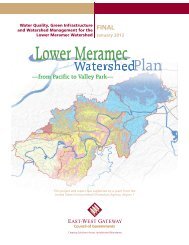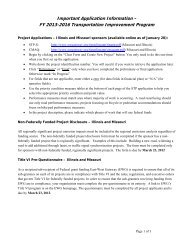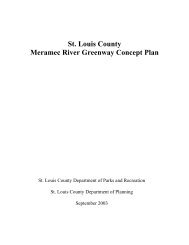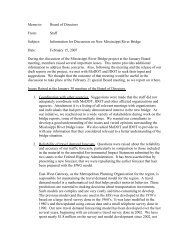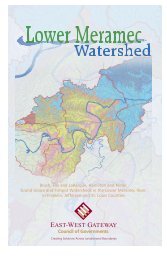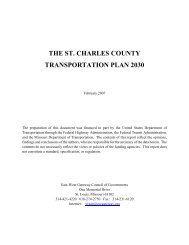- Page 1 and 2:
Jefferson County Hazard Mitigation
- Page 3 and 4:
Jefferson County Hazard Mitigation
- Page 5 and 6:
2 Jefferson County - Section 1 Ther
- Page 7 and 8:
4 Jefferson County - Section 1 pred
- Page 9 and 10:
6 FIGURE J4 SURFICIAL MATERIALS MAP
- Page 11 and 12:
8 KMOX 1120 AM KNLC-24 KNSX 93.3 FM
- Page 13 and 14:
10 Jefferson County - Section 1 TAB
- Page 15 and 16:
12 Jefferson County - Section 1 TAB
- Page 17 and 18:
14 Access to Employment; Incommutin
- Page 19 and 20:
16 Jefferson County - Section 1 acr
- Page 21 and 22:
18 Jefferson County - Section 1 •
- Page 23 and 24:
20 Jefferson County - Section 1 the
- Page 25 and 26:
22 Jefferson County - Section 1 use
- Page 27 and 28:
24 Jefferson County - Section 1 Tab
- Page 29 and 30:
26 Jefferson County - Section 1 Tab
- Page 31 and 32:
28 Jefferson County - Section 1 Tab
- Page 33 and 34:
30 Jefferson County - Section 1 Tab
- Page 35 and 36:
32 Jefferson County - Section 1 Tab
- Page 37 and 38:
34 Jefferson County - Section 1 "Ho
- Page 39 and 40:
36 Inventory of Infrastructures Jef
- Page 41 and 42:
38 Airports Jefferson County - Sect
- Page 43 and 44:
40 Jefferson County - Section 1 TAB
- Page 45 and 46:
42 Jefferson County - Section 1 Tab
- Page 47 and 48:
44 Jefferson County - Section 1 Tab
- Page 49 and 50:
46 Jefferson County - Section 1 Tab
- Page 51 and 52:
48 Jefferson County - Section 1 Tab
- Page 53 and 54:
50 Solid Waste Disposal Jefferson C
- Page 55 and 56:
52 Emergency Medical Services Jeffe
- Page 57 and 58:
54 Jefferson County - Section 1 TAB
- Page 59 and 60:
56 Jefferson County - Section 1 TAB
- Page 61 and 62:
58 Cities and Villages Housing unit
- Page 63 and 64:
60 Cities and Villages Building reg
- Page 65 and 66:
62 Cities and Villages Electric ser
- Page 67 and 68:
A Regional Overview All-Hazard Miti
- Page 69 and 70:
A Regional Overview All-Hazard Miti
- Page 71 and 72:
A Regional Overview All-Hazard Miti
- Page 73 and 74:
A Regional Overview All-Hazard Miti
- Page 75 and 76:
A Regional Overview All-Hazard Miti
- Page 77 and 78:
A Regional Overview All-Hazard Miti
- Page 79 and 80:
A Regional Overview All-Hazard Miti
- Page 81 and 82:
A Regional Overview All-Hazard Miti
- Page 83 and 84:
A Regional Overview All-Hazard Miti
- Page 85 and 86:
A Regional Overview All-Hazard Miti
- Page 87 and 88:
A Regional Overview All-Hazard Miti
- Page 89 and 90:
A Regional Overview All-Hazard Miti
- Page 91 and 92:
A Regional Overview All-Hazard Miti
- Page 93 and 94:
A Regional Overview All-Hazard Miti
- Page 95 and 96:
A Regional Overview All-Hazard Miti
- Page 97 and 98:
A Regional Overview All-Hazard Miti
- Page 99 and 100:
A Regional Overview All-Hazard Miti
- Page 101 and 102:
A Regional Overview All-Hazard Miti
- Page 103 and 104:
A Regional Overview All-Hazard Miti
- Page 105 and 106:
A Regional Overview All-Hazard Miti
- Page 107 and 108: A Regional Overview All-Hazard Miti
- Page 109 and 110: A Regional Overview All-Hazard Miti
- Page 111 and 112: A Regional Overview All-Hazard Miti
- Page 113 and 114: A Regional Overview All-Hazard Miti
- Page 115 and 116: A Regional Overview All-Hazard Miti
- Page 117 and 118: A Regional Overview All-Hazard Miti
- Page 119 and 120: A Regional Overview All-Hazard Miti
- Page 121 and 122: A Regional Overview All-Hazard Miti
- Page 123 and 124: A Regional Overview All-Hazard Miti
- Page 125 and 126: A Regional Overview All-Hazard Miti
- Page 127 and 128: A Regional Overview All-Hazard Miti
- Page 129 and 130: A Regional Overview All-Hazard Miti
- Page 131 and 132: A Regional Overview All-Hazard Miti
- Page 133 and 134: A Regional Overview All-Hazard Miti
- Page 135 and 136: A Regional Overview All-Hazard Miti
- Page 137 and 138: A Regional Overview All-Hazard Miti
- Page 139 and 140: A Regional Overview All-Hazard Miti
- Page 141 and 142: A Regional Overview All-Hazard Miti
- Page 143 and 144: A Regional Overview All-Hazard Miti
- Page 145 and 146: A Regional Overview All-Hazard Miti
- Page 147 and 148: A Regional Overview All-Hazard Miti
- Page 149 and 150: A Regional Overview All-Hazard Miti
- Page 151 and 152: A Regional Overview All-Hazard Miti
- Page 153 and 154: A Regional Overview All-Hazard Miti
- Page 155 and 156: A Regional Overview All-Hazard Miti
- Page 157: A Regional Overview All-Hazard Miti
- Page 161 and 162: A Regional Overview All-Hazard Miti
- Page 163 and 164: A Regional Overview All-Hazard Miti
- Page 165 and 166: A Regional Overview All-Hazard Miti
- Page 167 and 168: A Regional Overview All-Hazard Miti
- Page 169 and 170: A Regional Overview All-Hazard Miti
- Page 171 and 172: A Regional Overview All-Hazard Miti
- Page 173 and 174: A Regional Overview All-Hazard Miti
- Page 175 and 176: A Regional Overview All-Hazard Miti
- Page 177 and 178: A Regional Overview All-Hazard Miti
- Page 179 and 180: A Regional Overview All-Hazard Miti
- Page 181 and 182: A Regional Overview All-Hazard Miti
- Page 183 and 184: A Regional Overview All-Hazard Miti
- Page 185 and 186: A Regional Overview All-Hazard Miti
- Page 187 and 188: A Regional Overview All-Hazard Miti
- Page 189 and 190: A Regional Overview All-Hazard Miti
- Page 191 and 192: A Regional Overview All-Hazard Miti
- Page 193 and 194: A Regional Overview All-Hazard Miti
- Page 195 and 196: A Regional Overview All-Hazard Miti
- Page 197 and 198: A Regional Overview All-Hazard Miti
- Page 199 and 200: A Regional Overview All-Hazard Miti
- Page 201 and 202: A Regional Overview All-Hazard Miti
- Page 203 and 204: A Regional Overview All-Hazard Miti
- Page 205 and 206: A Regional Overview All-Hazard Miti
- Page 207 and 208: A Regional Overview All-Hazard Miti
- Page 209 and 210:
A Regional Overview All-Hazard Miti
- Page 211 and 212:
A Regional Overview All-Hazard Miti
- Page 213 and 214:
A Regional Overview All-Hazard Miti
- Page 215 and 216:
A Regional Overview All-Hazard Miti
- Page 217 and 218:
A Regional Overview All-Hazard Miti
- Page 219 and 220:
A Regional Overview All-Hazard Miti
- Page 221 and 222:
A Regional Overview All-Hazard Miti
- Page 223 and 224:
A Regional Overview All-Hazard Miti
- Page 225 and 226:
A Regional Overview All-Hazard Miti
- Page 227 and 228:
A Regional Overview All-Hazard Miti
- Page 229 and 230:
A Regional Overview All-Hazard Miti
- Page 231 and 232:
A Regional Overview All-Hazard Miti
- Page 233 and 234:
A Regional Overview All-Hazard Miti
- Page 235 and 236:
A Regional Overview All-Hazard Miti
- Page 237 and 238:
A Regional Overview All-Hazard Miti
- Page 239 and 240:
2 Jefferson County - Section 3 new
- Page 241 and 242:
4 Jefferson County - Section 3 Muni
- Page 243 and 244:
6 Jefferson County - Section 3 dama
- Page 245 and 246:
8 Federal Sources TITLE: PRE-DISAST
- Page 247 and 248:
10 Jefferson County - Section 3 gov
- Page 249 and 250:
12 TITLE: SOIL AND WATER CONSERVATI
- Page 251 and 252:
14 Policies and Programs (ex. Zonin
- Page 253 and 254:
2 Jefferson County - Section 4 by f
- Page 255 and 256:
4 The mitigation goals include the
- Page 257 and 258:
6 Jefferson County - Section 4 TABL
- Page 259 and 260:
8 Jefferson County - Section 4 d. E
- Page 261 and 262:
10 Jefferson County - Section 4 d.
- Page 263 and 264:
12 Monitoring, Evaluating and Updat
- Page 265 and 266:
14 Community Action Type of Strateg
- Page 267 and 268:
16 1,2,3,4,5,6,7,8,9, Revise flood-
- Page 269:
18 Encourage development of jurisdi



